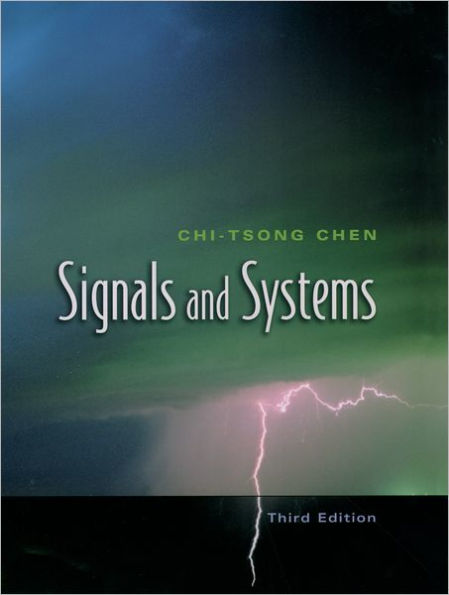Signals and Systems
The third edition of Signals and Systems prepares students for real-world engineering applications. It is concise, focused, and practical. The text introduces basic concepts in signals and systems and their associated mathematical and computational tools. It also stresses the most important concepts in signal analysis (frequency spectra) and system analysis (stability and frequency responses) and uses them throughout, including the study of seismometers and accelerometers.
Signals and Systems, 3/e, introduces every term carefully and develops every topic logically. It distinguishes amplitudes and magnitudes, as well as lumped and distributed systems. It presents engineering concepts as early as possible and discusses transform theory only as needed. Also, the text employs transfer functions and state-space equations only in the contexts where they are most efficient. Transfer functions are used exclusively in qualitative analysis and design, and state-space equations are used exclusively in computer computation and op-amp circuit implementation. Thus, the students' time is focused on learning only what can be immediately used.
Including an author commentary on the best way to approach the text, Signals and Systems, 3/e, is ideal for sophomore- and junior-level undergraduate courses in systems and signals. It assumes a background in general physics (including simple circuit analysis), simple matrix operations, and basic calculus.
1101398127
Signals and Systems, 3/e, introduces every term carefully and develops every topic logically. It distinguishes amplitudes and magnitudes, as well as lumped and distributed systems. It presents engineering concepts as early as possible and discusses transform theory only as needed. Also, the text employs transfer functions and state-space equations only in the contexts where they are most efficient. Transfer functions are used exclusively in qualitative analysis and design, and state-space equations are used exclusively in computer computation and op-amp circuit implementation. Thus, the students' time is focused on learning only what can be immediately used.
Including an author commentary on the best way to approach the text, Signals and Systems, 3/e, is ideal for sophomore- and junior-level undergraduate courses in systems and signals. It assumes a background in general physics (including simple circuit analysis), simple matrix operations, and basic calculus.
Signals and Systems
The third edition of Signals and Systems prepares students for real-world engineering applications. It is concise, focused, and practical. The text introduces basic concepts in signals and systems and their associated mathematical and computational tools. It also stresses the most important concepts in signal analysis (frequency spectra) and system analysis (stability and frequency responses) and uses them throughout, including the study of seismometers and accelerometers.
Signals and Systems, 3/e, introduces every term carefully and develops every topic logically. It distinguishes amplitudes and magnitudes, as well as lumped and distributed systems. It presents engineering concepts as early as possible and discusses transform theory only as needed. Also, the text employs transfer functions and state-space equations only in the contexts where they are most efficient. Transfer functions are used exclusively in qualitative analysis and design, and state-space equations are used exclusively in computer computation and op-amp circuit implementation. Thus, the students' time is focused on learning only what can be immediately used.
Including an author commentary on the best way to approach the text, Signals and Systems, 3/e, is ideal for sophomore- and junior-level undergraduate courses in systems and signals. It assumes a background in general physics (including simple circuit analysis), simple matrix operations, and basic calculus.
Signals and Systems, 3/e, introduces every term carefully and develops every topic logically. It distinguishes amplitudes and magnitudes, as well as lumped and distributed systems. It presents engineering concepts as early as possible and discusses transform theory only as needed. Also, the text employs transfer functions and state-space equations only in the contexts where they are most efficient. Transfer functions are used exclusively in qualitative analysis and design, and state-space equations are used exclusively in computer computation and op-amp circuit implementation. Thus, the students' time is focused on learning only what can be immediately used.
Including an author commentary on the best way to approach the text, Signals and Systems, 3/e, is ideal for sophomore- and junior-level undergraduate courses in systems and signals. It assumes a background in general physics (including simple circuit analysis), simple matrix operations, and basic calculus.
203.0
Out Of Stock
5
1

Signals and Systems
448
Signals and Systems
448Hardcover(New Edition)
$203.00
Related collections and offers
203.0
Out Of Stock

Product Details
| ISBN-13: | 9780195156614 |
|---|---|
| Publisher: | Oxford University Press |
| Publication date: | 03/18/2004 |
| Series: | The ^AOxford Series in Electrical and Computer Engineering |
| Edition description: | New Edition |
| Pages: | 448 |
| Product dimensions: | 9.47(w) x 7.65(h) x 1.00(d) |
About the Author
From the B&N Reads Blog
